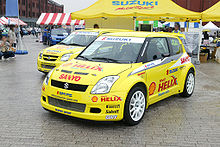Super 1600
| Super 1600 | |
|---|---|
| Motor racing formula | |
| Category | Rallying, Rallycross |
| Country or region | International |
| Championships | Various |
| Inaugural season | 2001 |
| Status | Defunct |
Super 1600, also known as S1600, is a
Technical details

Eligibility
Most FIA-approved rally car formulae are in some way production-based, from Super 1600 to World Rally car specification. This necessitates a process of homologation in Group A or N, before being modified within the limits of a formula's technical regulations. Such changes may include modified or entirely new parts in the engine, gearbox, suspension, bodywork and so on. In the Super 1600 formula, "suitable" is defined as a passenger car that has one driven axle (two-wheel drive) and a 4-cylinder engine that is of naturally aspirated configuration with a maximum volume of 1640cc.[1] At the time of homologation, the car must currently or have previously been in serial production with a minimum production number of 2500 vehicles.[2]
Though some manufacturers will operate their own motorsport programmes either directly or through a contractor, in many forms of production-based motorsport it is quite common for cars to be developed by independent constructors and specialist teams. In this case manufacturer approval is still required to homologate a new car. The Citroën C2 is an example of in-house development; the Ford Fiesta was developed by a contracted specialist (M-Sport); and the Opel Corsa was developed independently without technical assistance from GM.[3]
Modifications
The production car's standard gearbox is replaced by a sequential manual gearbox with a maximum of six forward ratios. The engine may be modified to produce a maximum power output of 230hp and the exhaust is subject to a noise restriction of 100dB at 4500rpm.[4]
As with the World Rally Car specification, Super 1600 requires a production-standard bodyshell that is made safe for competition with the addition of a roll cage. Certain other modifications can be made to increase the width of the bodywork and improve its aerodynamic efficiency. The weight of the competition car is reduced to a minimum of 980kg, with a lower minimum weight of 920 kg if an engine with only two valves per cylinder is employed.[5] In most cases, this is approximately 50 to 100 kg less than the weight of the production car version; the 1.6L Citroën C2, for example, weighs 1084 kg.[6]
Homologations

The following table shows the most notable S1600 cars that have competed at international level:

| Make | Model | JWRC wins [7]
|
|---|---|---|
| Citroën | C2 | 22 |
| Suzuki | Swift | 15 |
| Citroën | Saxo | 10 |
| Renault | Clio | 10 |
| Suzuki | Ignis | 9 |
| Fiat | Punto | 3 |
| Ford | Puma
|
1 |
| Volkswagen | Polo | 1 |
| MG | ZR | 0 |
See also
- Super 2000, a specification and classification for production based race cars
- Group N, a set of regulations in motorsport for production vehicles
References
- ^ Super 1600 Technical Regulations, 2006 Articles 4.1-4.4.
- ^ Super 1600 Technical Regulations, 2006 Article 1.1.
- ^ Corsa S1600 Specification corsasuper1600.com. Retrieved on April 21, 2007.
- ^ Super 1600 Technical Regulations, 2006 Article 4.7.
- ^ Super 1600 Technical Regulations, 2006 Article 12.
- ^ C2 Technical Specifications citroen.co.uk. Retrieved on April 22, 2007.
- ^ Seasons at World Rally Archive juwra.com. Retrieved on November 10, 2010.
